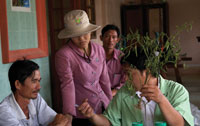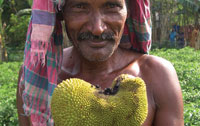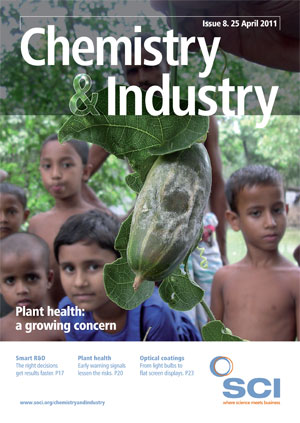It is estimated that one third to one half of all food produced globally is currently lost from ‘field to fork’. This is due to pre- and post-harvest losses as well as to waste in the retail sector and at the consumer’s table. Quantitative data on crop losses are limited, but estimates of 30 to 40% are common. A large proportion of this – estimates vary from 20–70% depending on the specific circumstances – is due to pests and diseases. And with climate change, trade flows and population movement all increasing, the rate at which these plant health problems arise and spread is also multiplying.

Another example is Coffee Wilt disease, which attacks coffee species in Central and Eastern Africa. Although coffee is not a staple food crop, its production has indirect implications for food security through decreasing income security.
Coffee Wilt kills coffee bushes so that, very soon after its detection, farmers experience a complete loss of income from coffee. A 77% loss in yield of robusta coffee at the national level in Uganda was reported in 2009.
Trans-boundary pests and diseases such as these, whose progress is currently hardly being monitored by anyone, are serious threats to food security. They jeopardise the livelihoods of millions, and therefore national economies and political security too. And yet few people outside the specialist scientific community are aware of them. In fact, there is surprisingly little general awareness of the importance of plant health, compared with human health and animal health, in protecting it.
Speaking to the UK newspaper The Observer on 23 January 2011, the UK’s chief scientist, John Beddington, commented: ‘Around 30% of food is lost before it can be harvested because it is eaten by pests that we never learnt how to control. We cannot afford that kind of loss to continue. GM should be able to solve that problem by creating pest-resistant strains, for example.’ Indeed, we hope it can. But during the five or so years that these pest-resistant crops are being developed, farmers will still have to deal with the pests that are currently attacking their crops, and prepare for those that will be doing so in two years’ time.
And while one set of scientists is researching new GM crops, others will be working on different timescales to develop pesticides and biocontrol agents for the pests that are threatening crops now and in the near future. In addition, they need to know when to stop research projects where the return on investment is becoming steadily less clear. It is estimated that a new crop protection product now takes between eight and nine years and more than US$200m to develop (Gisi and Leadbeater, 2009). New threats are constantly emerging, and scientists in both industry and academe need to keep abreast of the changing characteristics of existing plant pests and diseases, so they can stay on top of their control and eradication.
Not-for-profit agricultural organisation CABI has already started work on developing a tool that we believe could help. Management of pests and diseases is heavily dependent on early detection so that eradication can be attempted and, if this is not possible, management practices can be established. But just as there are few systems in place to gather data on pest losses, so systems for effective detection, identification and monitoring are not in place. With the right knowledge, we could identify pests and diseases earlier, slow down their spread and provide the correct treatments before yields are significantly affected.
A first step will be to pull together all the existing research and information about plant health, including historical information that is currently residing, perhaps in undigitised form, in databases, libraries and offices throughout the world. At the very least this will reduce the amount of time that scientists spend scouring unconnected websites for data – according to the Lexus Nexus database, in 2009 this equated to $28,000/person/year.

CABI’s plan is to develop a ‘knowledge bank’
CABI’s plan is to develop a ‘knowledge bank’ delivering a single point of access to all plant pest and disease information, both historical and current. We would bring together all the best information about plant pests and diseases, aggregate it, structure it, update it and make it searchable so that it will be possible to recognise complex patterns of information across multiple sites. We have a number of pieces of the jigsaw already in place, in the form of our existing data and publishing capability, including CAB Abstracts and the Crop Protection Compendium (CPC), and content from organisations including the Food and Environment Research Agency (FERA), the International Rice Research Institute (IRRI), the International Maize and Wheat Improvement Centre (CIMMYT) and Biodiversity International. But we are actively seeking new information partners who are willing to contribute data and allow them to be made available.
Further information will be provided in the form of local observations from our network of plant clinics. The clinics advise farmers in developing countries on pests and diseases in the way a health centre does for humans. They are run by local technical people, trained by CABI and known as ‘plant doctors’, who visit rural markets every week. Farmers drop by with samples of diseased plants, to get the problem identified and to learn what to do about it.
As well as providing immediate benefits to local farmers, the clinics are in some cases already acting as a field-based early detection system, helping to monitor plant pests and diseases.
For example, in November 2006, oranges covered in black spot symptoms were brought to the rural plant clinic at Katine market near Soroti in Uganda. These blemishes were reducing the aesthetic value and saleability of the fruit, which was a major problem for local farmers. Samples were sent back to CABI’s laboratories in the UK, where Citrus Black Spot caused by Guignardia citricarpa was diagnosed. This was the first confirmed record of Guignardia from Uganda, although it had been reported from other African countries including Kenya, Mozambique, South Africa, Zambia and Zimbabwe.
Since the first CABI plant clinic was established in 2002, these clinics have helped in the identification of over 50 new diseases; we believe that this makes them the largest single source of information about new plant and disease threats in the world. With a planned increase in the number of clinics – from 80 to 400 over the next five years – we can expect much greater reporting of emerging problems, which can then be digitised, displayed on an interactive map and presented alongside other digitised displays of variables, such as soil, climate models, trade routes and terrain.
For, as we know, where a pest or disease is causing trouble now is only half the story. By producing a detailed, current, and continuously updated picture we will be in a much better position to see patterns and predict where and how problems may develop and spread. We may also be able to predict how changes in the environment will create conditions conducive to changing today’s minor pests into tomorrow’s major threats. This will allow governments, development agencies, research institutions and companies to target research and development and resources so that we are not in a perpetually reactive mode, as at present.
Of course, as with human health, the availability of all this knowledge at policy level is going to be of no use if we cannot ensure that it trickles down in a usable form to the people working with plants in the field. Even a national or regional focus can be just too wide. In East and Southern Africa, for example, the armyworm is a major threat – appearing suddenly in large numbers and ravaging crops. There have been national forecasting systems in place to warn farmers about possible outbreaks during the growing season; however, given the localised nature of attacks and the difficulties of communicating with widely dispersed rural communities, they simply have not given the farmers the pinpoint-accurate information they needed at the right time.
In the case of armyworm, a community-based forecasting system has now been developed that allows farmers to find and control the caterpillars before they cause significant damage. Indeed, after three seasons of using the system, 82% of farmers were able to control a recent major outbreak in Tanzania. But it reinforces the importance of being able to operate practically at this literally grass-roots level.
As well as diagnosis and surveillance, an important part of the plant doctors’ work is at the ‘prescription’ stage. For smallholder farmers, particularly in rural areas, getting hold of any pesticides can be a problem. But an even greater problem can be selecting the correct legitimate pesticide and then using it correctly.
Rather as when we may occasionally take medicine for both a chesty cough and a tickly cough, just to be sure, so the unsupported farmer will often spray fairly indiscriminately whatever pesticide or combination of pesticides that he or she can get hold of. And then wonder why it doesn’t work. Improved knowledge about the location and spread of pests would not only allow manufacturers to target the supply of appropriate pesticides, but also prepare plant doctors to advise on their use.
The earlier we know about a threat and the more we know, the more accurately we can assess risk, focus our research efforts, make policy decisions, begin to develop treatments and deliver advice to farmers. Paying as much attention to plant health as to human and animal health will start to pay dividends in ensuring the food security of millions more people across the world.
Caroline Scotter-Mainprize is corporate communications manager at CABI, based in Wallingford, Oxfordshire, UK.





